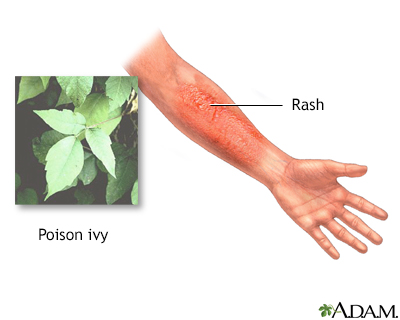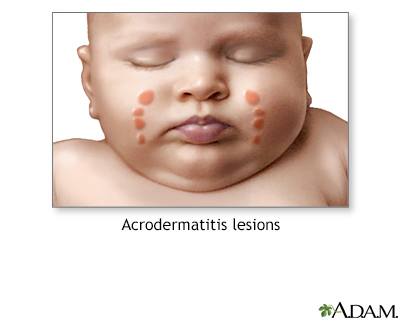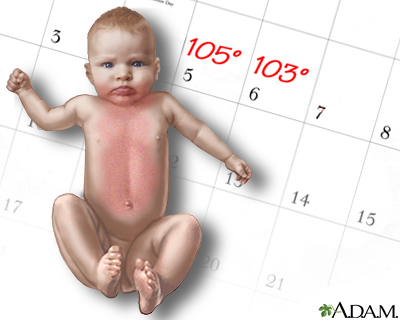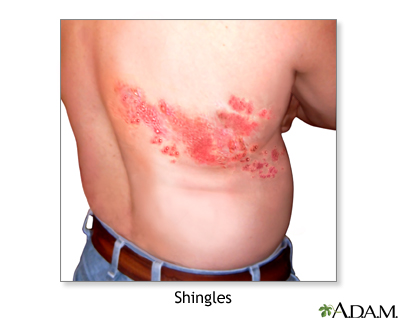Rashes
Skin redness or inflammation; Skin lesion; Rubor; Skin rash; Erythema
Rashes involve changes in the color, feeling or texture of your skin.

A rash is an eruption of changes in color or texture of the skin.

Poison oak rash on the arm. Several plants produce toxins that cause skin reaction. This is the appearance of poison oak dermatitis. Note the typical linear streaks produced either by scratching or brushing against the plant. (Image courtesy of the Centers for Disease Control and Prevention.)

Newborn infants may have Erythema toxicum, a rash that is characterized by patchy redness with central vesicles. The rash is temporary, and the location may move (transient). (Image courtesy of the Centers for Disease Control and Prevention.)

Acrodermatitis enteropathica is a skin condition peculiar to children that may be accompanied by mild symptoms of fever and malaise. It may also be associated with hepatitis B infection or other viral infections. The lesions appear as small coppery-red, flat-topped firm papules that appear in crops and sometime in long linear strings, often symmetric.

Roseola is an acute disease of infants and young children that is characterized by high fever followed by a rash that appears on trunk, limbs, neck and face.

Shingles, or herpes zoster, is caused by the same virus that causes chickenpox. The virus can lie dormant in the body for many years and re-emerge as shingles. Shingles appear as a painful rash. It consists of red patches of skin with small blisters (vesicles) that look very similar to early chickenpox. Shingles usually clears in 2 to 3 weeks and rarely recurs.

Cellulitis is a deep infection of the skin, usually accompanied by generalized (systemic) symptoms such as fever and chills. The area of redness increases in size as the infection spreads. The center of the circled lesion has been biopsied.

When redness appears in ring shapes on the body, it is referred to as erythema annulare, shown here on the forearm. There are generally no symptoms, with the exception of mild itching (pruritus). It may be associated with serious diseases, but in the majority of cases, an underlying illness is never discovered.

This is a picture of guttate (drop-shaped) psoriasis on the arms and chest. Guttate psoriasis is a rare form of psoriasis. It frequently follows a streptococcal infection, appears rapidly and affects the face, chest, and nearest limbs. The patches are small and round or oval and have the typical appearance of psoriasis. This photograph shows the diffuse and widespread coverage on the arm and chest.

This is a picture of guttate (drop-shaped) psoriasis on face and neck. Guttate psoriasis is a rare form of psoriasis. It frequently follows a streptococcal infection, appears rapidly and affects the face, chest, and nearest limbs. The patches are small and round or oval and have the typical appearance of psoriasis. This photograph shows the diffuse and widespread coverage on the face and neck.

This is a photo of a systemic lupus erythematosis rash on the face. Lupus erythematosis often produces a butterfly rash or malar rash. Typically, the rash also appears on the nose.

This is a typical early appearance of a poison ivy rash, located on the knee. These early lesions consist of multiple small blisters (vesicles), often in a line where the skin has brushed against the poison ivy plant. The person may then spread the toxin to other areas of the body by scratching.

This is a typical early appearance of a poison ivy rash, located on the leg. These early lesions consist of multiple small blisters, often in a line where the skin has brushed against the poison ivy plant. The rash is caused by skin contact with the oily sap (resin) of these plants. The oily resin usually enters the skin rapidly, and is seldom transferred from person to person. The rash is not caused by the fluid from the blisters. Thus, once the person has washed the oil off the skin, the rash is usually not contagious.

Erythema multiforme lesions are circular and may appear in concentric rings (often called target lesions). Target lesions may also be associated with other medical conditions such as herpes infection, streptococcal infection, tuberculosis (TB), or as a reaction to chemicals or medications.

Erythema multiforme lesions are often referred to as target lesions because of the concentric rings the lesions produce. The target appearance is well demonstrated in this photograph.

The red spots on this person's back appear where blisters (bullae) caused by Erythema multiforme have ruptured and the overlying skin removed (denuded). The resulting lesions are yellow-crusted ulcers (erosions). Erythema multiforme may be associated with herpes simplex infection, mycoplasma pneumonia, or other medical conditions such as streptococcal infection, tuberculosis (TB), or may result from exposure to chemicals or medications.
Considerations
Often, the cause of a rash can be determined from how it looks and its location and symptoms. Skin testing, such as a scraping, culture, or biopsy, may also be used to help with diagnosis. Sometimes, the cause of the rash remains unknown.
Causes
A rash is often due to dermatitis, meaning inflammation of the skin. Contact dermatitis is caused by things your skin touches, such as:
- Chemicals in elastic, latex, and rubber products
- Cosmetics, soaps, and detergents
- Dyes and other chemicals in clothing
- Poison ivy, oak, or sumac
Seborrheic dermatitis is a rash that appears in patches of redness and scaling around the eyebrows, eyelids, mouth, nose, trunk, and behind the ears. If it happens on your scalp, it is called dandruff in adults and cradle cap in infants.
Age, stress, fatigue, weather extremes, oily skin, infrequent shampooing, and alcohol-based lotions aggravate this harmless but bothersome condition.
Other common causes of a rash include:
- Eczema (atopic dermatitis) -- Tends to happen in people with allergies or asthma. The rash is generally red, itchy, and scaly.
- Psoriasis -- Tends to occur as red, scaly, patches over joints and along the scalp. It is sometimes itchy. Fingernails may also be affected.
- Impetigo -- Common in children, this infection is from bacteria that live in the top layers of the skin. It appears as red sores that turn into blisters, ooze, then form a honey colored crust over all or part of the rash.
- Shingles -- A painful blistered skin condition caused by the same virus as chickenpox. The virus can lie dormant in your body for many years and re-emerge as shingles. It usually affects only one side of the body.
- Childhood illnesses such as chickenpox, measles, roseola, rubella, hand-foot-mouth disease, fifth disease, and scarlet fever.
- Medicines
- Insect bites or stings.
Many medical conditions can cause a rash as well. These include:
- Lupus erythematosus (an immune system disease)
- Rheumatoid arthritis, especially the juvenile type
- Kawasaki disease (inflammation of the blood vessels)
- Certain body-wide (systemic) viral, bacterial or fungal infections
Home Care
Many simple rashes will improve with gentle skin care and by avoiding irritating substances. Follow these general guidelines:
- Avoid scrubbing your skin.
- Use gentle cleansers.
- Avoid applying cosmetic lotions or ointments directly on the rash.
- Use warm (not hot) water for cleaning. Pat dry, don't rub.
- Stop using any recently added cosmetics or lotions.
- Leave the affected area exposed to the air as much as possible.
- Try calamine medicated lotion for poison ivy, oak, or sumac, as well as for other types of contact dermatitis.
Hydrocortisone cream (1%) is available without a prescription and may soothe many rashes. Stronger hydrocortisone or other steroid creams are available with a prescription. If you have eczema, apply moisturizers over your skin. Try oatmeal bath products, available at drugstores, to relieve symptoms of eczema or psoriasis. Oral antihistamines may help relieve itchy skin.
When to Contact a Medical Professional
Call 911 or the local emergency number if:
- You are short of breath, your throat is tight, or your face is swollen.
- Your child has a purple rash that looks like a bruise.
Contact your health care provider if:
- You have joint pain, fever, or a sore throat.
- You have streaks of redness, swelling, or very tender areas as these may indicate an infection.
- You are taking a new medicine. Do not change or stop any of your medicines without contacting your provider.
- You may have a tick bite.
- Home treatment doesn't work, or your symptoms get worse.
What to Expect at Your Office Visit
Your provider will perform a physical exam and ask about your medical history and symptoms. Questions may include:
- When did the rash begin?
- What parts of your body are affected?
- Does anything make the rash better? Worse?
- Have you used any new soaps, detergents, lotions, or cosmetics recently?
- Have you been in any wooded areas recently?
- Have you noticed a tick or insect bite?
- Have you had any change in your medicines?
- Have you eaten anything unusual?
- Do you have any other symptoms, like itching or scaling?
- What medical problems do you have, such as asthma or allergies?
- Have you recently traveled out of the area where you live?
Tests may include:
- Allergy testing
- Blood tests
- Skin biopsy
- Skin scrapings
Depending on the cause of your rash, treatments may include medicated creams or lotions, medicines taken by mouth, or skin surgery.
Many primary care providers are comfortable dealing with common rashes. For more complicated skin disorders, you may need a referral to a dermatologist.
References
James WD, Elston DM, Treat JR, Rosenbach MA, Neuhaus IM. Cutaneous signs and diagnosis. In: James WD, Elston DM, Treat JR, Rosenbach MA, Neuhaus IM, eds. Andrews' Diseases of the Skin. 13th ed. Philadelphia, PA: Elsevier; 2020:chap 2.
Ko CJ. Approach to skin diseases. In: Goldman L, Cooney KA, eds. Goldman-Cecil Medicine. 27th ed. Philadelphia, PA: Elsevier; 2024:chap 403.
Version Info
Last reviewed on: 10/14/2024
Reviewed by: Elika Hoss, MD, Assistant Professor of Dermatology, Mayo Clinic, Scottsdale, AZ. Also reviewed by David C. Dugdale, MD, Medical Director, Brenda Conaway, Editorial Director, and the A.D.A.M. Editorial team.
